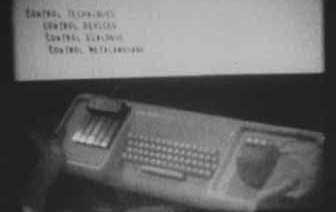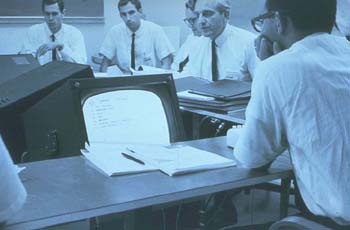NewMedia History : is it that new (4) ?

oNLine System (NLS) demonstration at the 1968 Fall Joint Computer Conference
Engelbart and team working with networked NLS computers |
Douglas Engelbart | Augmentation <1968>"Our goal of augmenting the human intellect will exhibit more of what can be called intelligence than an unaided human could by organizing his intellectual capabilities into higher levels of synergistic structuring."Invented mouse, windows, e-mail, and the word processor.Led one of the most important projects funded by ARPA in the 1960s: a networked environment designed to support collaborative interaction between people using computers => NLSDouglas Engelbart is one of the most influential thinkers in the history of personal computing. He is best known as the groundbreaking engineer who invented such mainstays of the personal computer as the mouse, windows, e-mail, and the word processor. Engelbart led one of the most important projects funded by ARPA (Advanced Research Projects Agency) in the 1960s: a networked environment designed to support collaborative interaction between people using computers. It was dubbed the NLS (oNLine System). This historic prototype, developed at the Stanford Research Institute, and unveiled in 1968 at the Fall Joint Computer Conference in San Francisco, influenced the development of the first personal computer and the graphical user interface at Xerox PARC in the early 1970s. Engelbart reasoned that networked computing would not only make individuals more intellectually effective; it would enable a collaborative method of sharing knowledge. The linking of people and computers using this approach to interactivity would result in the use of computers to "solve the world's problems" by augmenting the capacities of the mind's intellectual faculties. |
Douglas Engelbart expanded on Bush's premise. His quest to "augment human
intelligence," as he aptly phrased it, was based on the insight that the
open flow of ideas and information between collaborators was as important to
creativity as private free association. The personal computer, as he envisioned
it, would not only allow for the arrangement of data in idiosyncratic, non-linear
formats. By connecting workstations to a data-sharing network and turning them
into communications devices, Engelbart's oNLine System allowed for a qualitative
leap in the collaboration between individuals -- almost as if colleagues could
peer into one another's minds as part of the creative process. In the early
1960s, experiments with networked personal computing promised the non-linear
organization of information on a grand scale.
Source : http://www.artmuseum.net/w2vr/timeline/Engelbart.html
